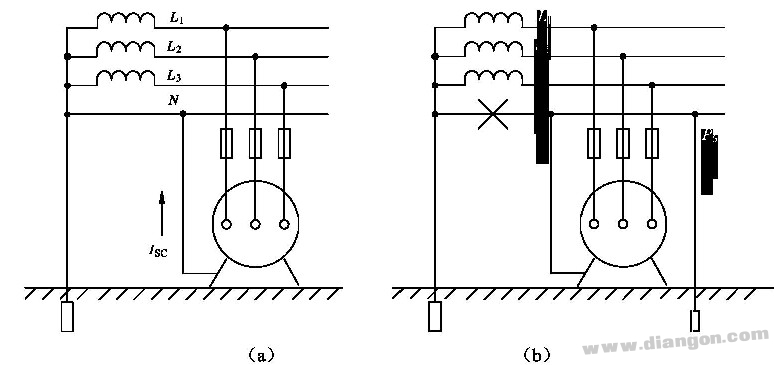When electrical equipment is in operation, if insulation damage or breakdown occurs, the outer casing may become energized. If a person touches the casing, an electric shock can occur. To prevent this, it is essential to connect the equipment to ground through proper grounding methods, known as protective earthing. This ensures that in case of a fault, the current flows safely into the earth instead of through a person’s body.
1. Concept and Principle of Protective Earthing
Protective earthing involves connecting the exposed metal parts of equipment, such as the casing or frame, to the ground. This is especially important in systems where the neutral point is not grounded. In such cases, if the equipment becomes energized due to a fault, the current will flow through the grounding system rather than through a person. The grounding system consists of two main components: the grounding electrode (a conductor buried in the earth) and the grounding wire (which connects the equipment to the electrode). The total resistance of the grounding system is called the grounding resistance.
The principle behind protective earthing is based on the difference in resistance between the human body and the grounding system. Normally, the human body has a resistance of around 600–1000 ohms, while the grounding resistance is typically less than 4 ohms. This means that when a fault occurs, most of the current will flow through the grounding system, leaving only a small amount to pass through the body, making it safe.
This method is effective in low-voltage ungrounded systems. However, in grounded systems where the neutral point is connected to the earth, the fault current is much higher, and protective earthing alone may not be sufficient. In such cases, protection by zero connection (also known as earthing via the neutral line) is more appropriate.
2. Concept and Principle of Protective Zero Connection
Protective zero connection refers to connecting the exposed parts of the equipment directly to the neutral line of the power supply in a system where the neutral point is already grounded. This creates a low-resistance path for fault currents, ensuring that any fault quickly triggers the circuit breaker or fuse, cutting off the power supply and preventing electric shocks.
In normal operation, the exposed parts are not energized. If a person touches them, they would only come into contact with the neutral line, which is at ground potential, so there is no risk of electric shock. However, it's important to note that protective earthing and protective zero connection should not be mixed, and the working ground of the neutral point must be reliable to ensure safety.
3. Repeated Grounding
In systems where the neutral line is already grounded, repeated grounding is used to enhance the effectiveness of protective zero connection. This involves re-grounding the neutral line or the grounding wire at certain intervals along the distribution network. This helps maintain a stable ground reference even if the main neutral line breaks.
If the neutral line is broken, the exposed parts of the equipment may become energized, posing a serious risk. With repeated grounding, the voltage on these parts is significantly reduced, minimizing the danger to people. However, it's crucial to avoid disconnections in either the neutral or grounding wires, as this can compromise the entire system.
4. Leakage Protection
Leakage protection is a modern method designed to detect and respond to electrical faults before they cause harm. These devices monitor the current flowing through the circuit and automatically disconnect the power supply when a leakage or grounding fault is detected. Even if a person is not yet in contact with the faulty equipment, the system can cut off the power before any injury occurs.
There are various types of leakage protectors available today, but transistor-based models are widely used due to their reliability and fast response time. They play a critical role in enhancing electrical safety in both residential and industrial environments.

Figure: Working principle of protection zero connection
ZOOKE provides you with safe and reliable connector products, with 5.7 spacing products providing more possibilities for limited space and creating more value for the research and development and production of terminal products.
5.70 wire to board connectors,5.7 connectors,ZOOKE connectors
Zooke Connectors Co., Ltd. , https://www.zooke.com